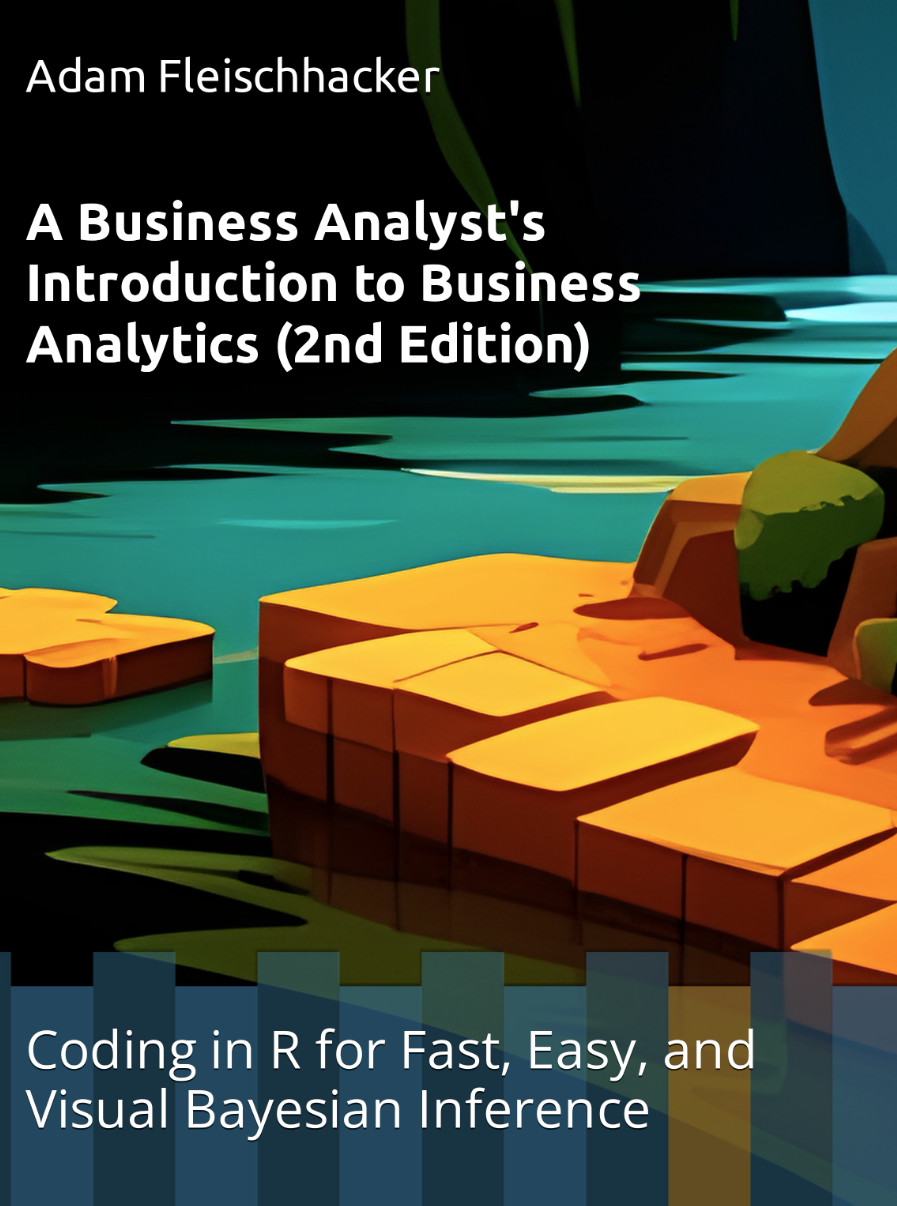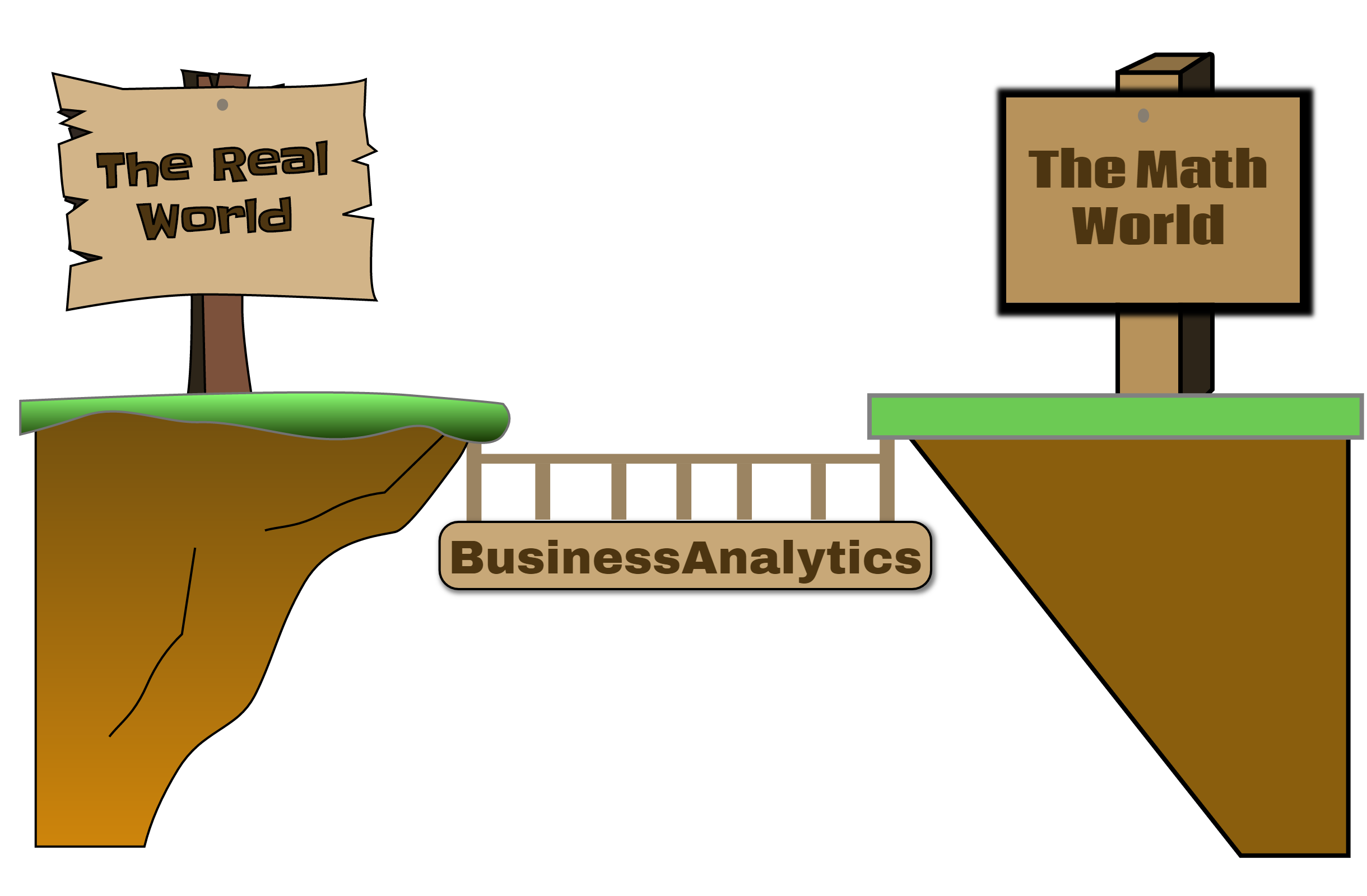A Business Analyst’s Introduction to Business Analytics (Second Edition)
Coding in R For Fast, Easy, and Visual Bayesian Inference
Adam Fleischhacker
2025-01-15
Chapter 1 Welcome
 Figure 1.1: Buy a beautifully printed in-color version of “A Business Analyst’s Guide to Business Analytics(2e)” on Amazon: http://www.amazon.com/dp/B0CFZMKRGX.
Figure 1.1: Buy a beautifully printed in-color version of “A Business Analyst’s Guide to Business Analytics(2e)” on Amazon: http://www.amazon.com/dp/B0CFZMKRGX.
There are three languages at the core of any data-driven business analysis. I label the three languages narrative, math, and code:
Narrative: This is the language of your real-world understanding, the story of you, your business challenges, and possible ways to improve the future.
Math: Hopefully, this is the language describing a faithful mathematical representation of your real-world narrative whose solution or output might turn your data into data-driven insight.
Code: This is your programming language, the code required to generate output that exactly or approximately solves your math problem or generates your desired output.
Unifying narrative, math, and code is the objective of any good business analyst and it is my goal with this book to train your mind to think this way.
While numerous other data analysis books may trap you in intricate technical details and pitfalls of mathematics and computation, this beginner’s textbook prioritizes boosting your confidence to handle these complexities in due time. Within this text, we maintain a continuous flow between real-world situations and mathematical concepts, honing the ability to traverse the analytics bridge illustrated in Figure 1.2. Although it places less emphasis on technical intricacies, this book significantly concentrates on skillfully connecting mathematical principles and coding with real-life situations. This equips you to collaborate seamlessly with business experts and champion enhanced decisions and actions in practical contexts.
Figure 1.2: When digesting this book, strive to become the business analyst who easily travels between the real-world of business and the theoretical world of mathematics. Learn to translate real-world scenarios into both mathematical and computational representations that yield actionable insight. Plan to astound your stakeholders with insights that alter and improve their real-world decisions.

By learning to program in R, manipulate and visualize data in the tidyverse, and model business scenarios in the visual language of Bayesian inference with causact, you will proficiently articulate and unlock insightful narratives utilizing data, models, and visualization. In essence, you will become a skilled translator proficiently conversant in narrative, math, and code.
Thank you for investing your time in this book and I look forward to being on this journey with you.
1.2 Accompanying Videos and Online Materials
Videos that help the material come to life are available on my YouTube channel. Each chapter’s video should be watched after reading and coding along with the textbook. Some of the older videos which accompanied the first edition of this book use library(greta) and dag_greta() functions; when you see these commands, just delete the library(greta) command and replace dag_greta() with dag_numpyro(). To get the videos, search for Adam Fleischhacker on YouTube or follow this link directly: https://www.youtube.com/playlist?list=PLassxuIVwGLPy-mtohX-NXrjD8fc9FBOc. You can copy and paste code from the online version of the textbook (https://causact.com/).
1.3 Notes About This Book
At its heart, this is an introduction to R accompanied by an introduction to the math of data science through the lens of computational Bayesian inference.
To use the datasets and functions that accompany this book, readers should install the causact R package and some Python dependencies. The installation process is typically very smooth and additional information about the package and its installation can be found here in subsequent chapters and also here: https://github.com/flyaflya/causact.
Please note that this work is licensed under the Creative Commons Attribution-NonCommercial-NoDerivatives 4.0 International (https://creativecommons.org/licenses/by-nc-nd/4.0/).
To support this work send feedback/follow me via Twitter:
and consider buying the printed

A Business Analyst’s Introduction to Business Analytics by Adam Fleischhacker is licensed under a Creative Commons Attribution-NonCommercial-NoDerivatives 4.0 International License.